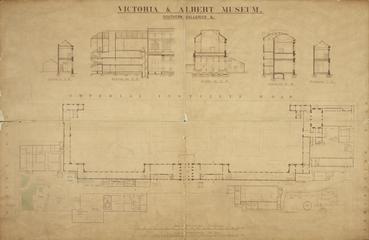
Victoria and Albert Museum
The Victoria and Albert Museum, often referred to as the V&A, has its origins in the Great Exhibition of 1851, which the museum's first director, Henry Cole, was involved in planning. It was initially known as the Museum of Manufactures and first opened in May 1852 at Marlborough House, but by September had been transferred to Somerset House. At this stage the collections covered both applied art and science. Several of the exhibits from the Great Exhibition were purchased to form the nucleus of the collection. Henry Cole declared that the Museum should be a “schoolroom for everyone”, with the mission of improving the standards of British industry by educating designers, manufacturers and consumers in art and science. Acquiring and displaying the best examples of art and design contributed to this, as did the construction of the museum’s buildings themselves, which were also intended to demonstrate exemplary design and decoration.
By February 1854 discussions were underway to transfer the museum to the current site at South Kensington and it was renamed South Kensington Museum. The official opening by Queen Victoria was on 20 June 1857. In these early years the practical use of the collection was very much emphasised and the first Keeper of the Fine Art Collection, George Wallis, passionately promoted the idea of wide art education through the museum collections. This led to the transfer to the museum of the School of Design that had been founded in 1837 at Somerset House. After the transfer it was referred to as the Art School or Art Training School and later became the Royal College of Art, achieving full independence from the V&A in 1949.
From the 1860s to the 1880s the V&A’s scientific collections were moved from the main museum site to various improvised galleries to the west of Exhibition Road. In 1893 the Science Museum effectively came into existence when a separate director was appointed, though construction did not commence on the Science Museum building until 1914.
The laying of the foundation stone of the Aston Webb building (to the left of the main entrance) on 17 May 1899 was the last official public appearance by Queen Victoria. It was during this ceremony that the change of name from 'South Kensington Museum' to 'Victoria and Albert Museum' was made public.
On the outbreak of the Second World War, most of the collection was sent to a quarry in Wiltshire, to Montacute House in Somerset, or to a tunnel near Aldwych tube station, with larger items remaining in situ, sand-bagged and bricked in. Some of the V&A’s galleries and spaces were used to support the war effort. After the war ended and before the collections returned to the museum, the Britain Can Make It exhibition was held between September and November 1946. This attracted nearly a million-and-a-half visitors and its success led to the planning of the Festival of Britain in 1951.
Today, the V&A is the world’s leading museum of art and design, housing a permanent collection of over 2.3 million objects that span over 5,000 years of human creativity. The Museum holds many of the UK's national collections and houses some of the greatest resources for the study of architecture, furniture, fashion, textiles, photography, sculpture, painting, jewellery, glass, ceramics, book arts, Asian art and design, theatre and performance.